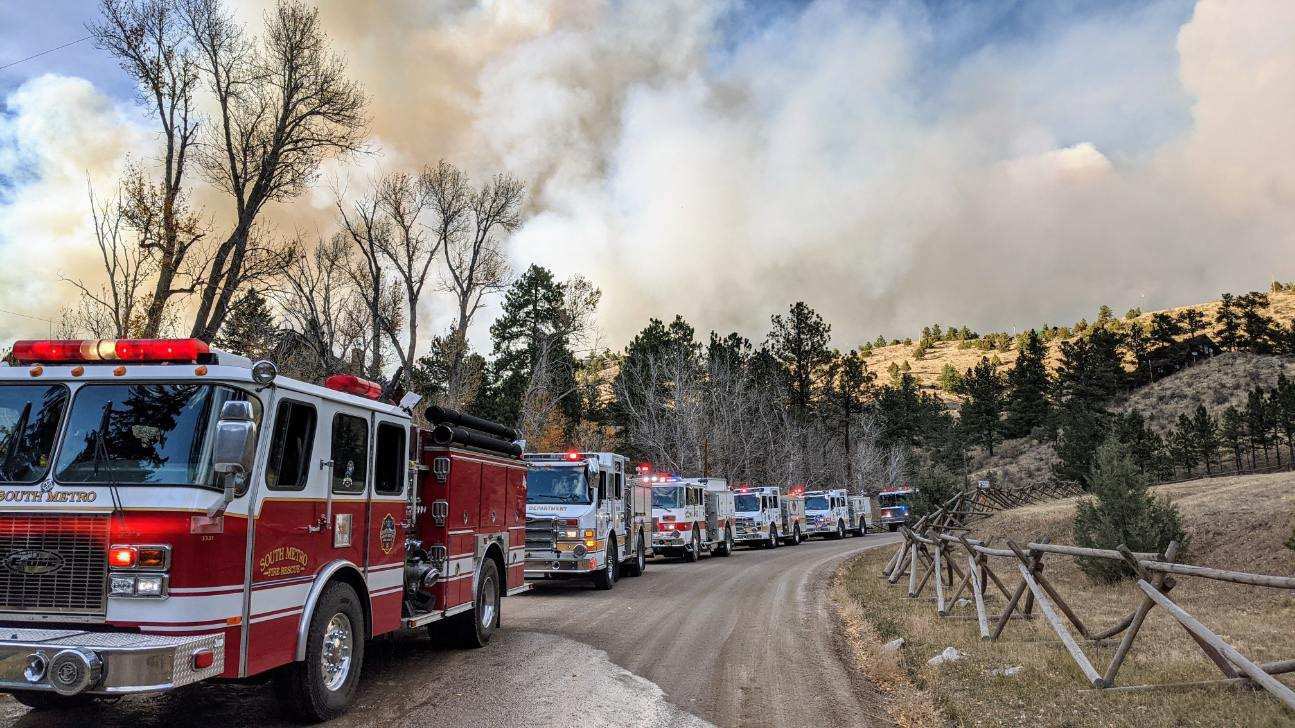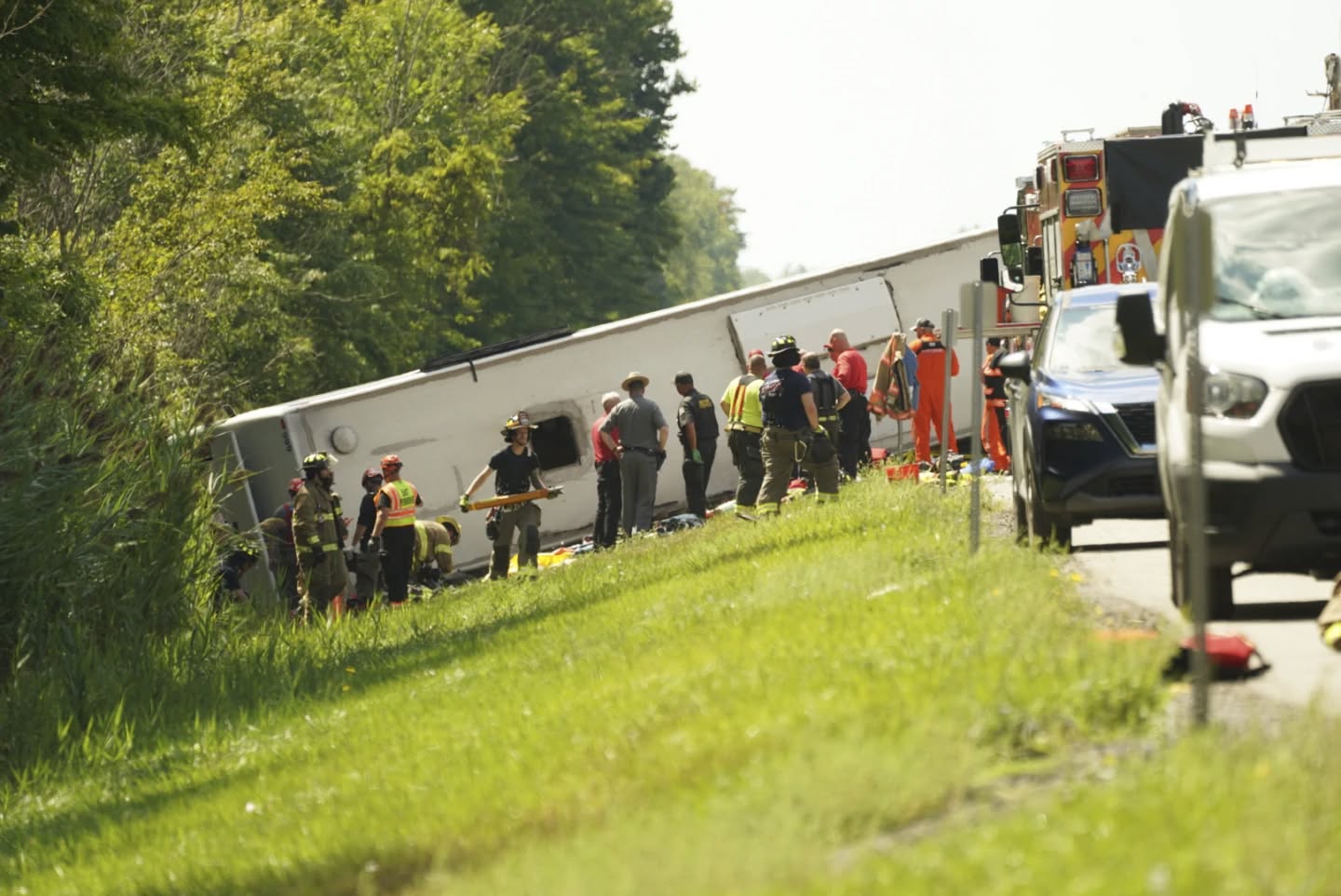A Sudden Tragedy on New York’s Highways
Friday afternoon in western New York began like any other summer day for travelers returning from Niagara Falls. Families, tourists, and visitors were making their way back toward New York City after enjoying one of the world’s most famous natural wonders. But for more than fifty passengers aboard a tour bus, the day took a devastating turn when their vehicle rolled over on Interstate 90 near Pembroke, about 25 miles east of Buffalo.
Authorities immediately declared the scene a “mass casualty” incident, underscoring the seriousness of the crash and the scale of emergency response required. Though details are still emerging, the event has already become one of the most significant transportation accidents in the region in recent years.

Immediate Emergency Response
First responders from across Genesee County and neighboring areas rushed to the scene. Ambulances, fire crews, and even medical helicopters were dispatched within minutes. Hospitals in Buffalo, including Oishei Children’s Hospital, mobilized resources to receive multiple patients at once.
Officials described the response as one of the largest coordinated emergency efforts in the Buffalo area’s history. Beyond tending to injuries, responders also worked to stabilize the site, manage traffic along the busy interstate, and provide information to concerned relatives and communities both in New York and abroad.

Passengers and Their Journeys
The bus had been carrying families from diverse backgrounds, many identified as Filipino, Indian, and Chinese tourists. For most, the trip represented an opportunity to experience the natural beauty of Niagara Falls and bond with loved ones. The crash abruptly transformed a day of sightseeing into an event marked by uncertainty and fear.
In moments like these, the global nature of tourism becomes clear. The incident has not only affected communities in New York State but also families around the world who await news of their relatives. This international dimension adds another layer of complexity to recovery and communication efforts.

Witness Accounts
Motorists traveling along I-90 at the time described scenes of chaos and disbelief. Powell Stephens, a driver who passed by shortly after the crash, shared with The Buffalo News that he saw shattered windows, scattered luggage, and people’s belongings strewn across the roadway. His account reflects the suddenness of the accident and the overwhelming sense of disarray that followed.
These testimonies highlight how quickly an ordinary day can be transformed into a life-altering moment, underscoring the unpredictability of road travel.
Leadership Reactions
Governor Kathy Hochul was briefed shortly after the crash and expressed condolences, calling the incident “heartbreaking.” New York Attorney General Letitia James also released a statement, emphasizing her prayers and support for those impacted. Their responses reflect the gravity of the event and the state’s commitment to ensuring proper investigation and assistance.
Local officials, too, emphasized resilience. Community leaders have begun discussing ways to support not only the survivors but also the broader network of families affected by the tragedy.
The Importance of Road Safety
Tour bus travel remains one of the most common ways for groups to experience destinations like Niagara Falls. Yet, the incident near Buffalo serves as a stark reminder of the risks inherent in long-distance highway travel. Investigators have not yet released an official cause, but authorities confirmed they will examine multiple factors: driver condition, vehicle maintenance, road conditions, and weather at the time of the crash.
Transportation safety experts note that incidents of this scale highlight the need for:
-
Regular vehicle inspections for tour operators.
-
Stronger enforcement of driver rest and shift regulations.
-
Enhanced emergency preparedness for mass transit companies.
-
Clear safety communication to passengers before trips.
By studying accidents like this, officials aim to prevent future tragedies and reassure travelers that lessons learned are being applied.
The Human Impact
Beyond numbers and investigations, this crash is foremost about people—families whose lives have been altered, communities offering support, and first responders who stepped into action under intense pressure. Survivors now face not only physical recovery but also the emotional aftermath of such a sudden and traumatic event.
For the families of those who were most seriously affected, grief and uncertainty are now intertwined with a search for answers. International embassies and consulates are expected to play a role in helping foreign families navigate communication, hospital care, and arrangements in the United States.
Niagara Falls and Tourism
Niagara Falls welcomes millions of visitors each year, making it one of North America’s premier destinations. Tour buses, in particular, are a staple of the industry, ferrying groups of tourists from major cities to the iconic waterfalls.
This accident will likely prompt renewed conversations about how tourism companies balance cost, efficiency, and passenger safety. Travel experts predict that authorities may push for stricter safety certifications and accountability measures for bus operators that frequently carry international tourists.
A Community Pulls Together
As news of the crash spread, local communities near Buffalo responded with remarkable compassion. Volunteers offered assistance, local churches and organizations prepared to provide shelter for stranded travelers, and hospital staff worked overtime to manage the influx of patients.
This spirit of resilience reflects a broader truth: while accidents may disrupt lives in profound ways, the collective effort of communities often becomes a source of strength in the aftermath.
Looking Ahead: The Investigation
The New York State Police and the National Transportation Safety Board (NTSB) are expected to lead the formal investigation. Their focus will likely include:
-
Whether the bus met all federal and state safety regulations.
-
The condition of the driver at the time of the crash.
-
Any mechanical issues or design flaws in the vehicle.
-
How emergency response protocols were executed.
Preliminary findings will be shared in the coming weeks, but comprehensive reports may take months. Until then, officials urge patience and caution against speculation.
Lessons for Travelers
For travelers and families planning similar trips, this incident underscores several key lessons:
-
Always confirm the safety record and licensing of tour operators.
-
Familiarize yourself with basic safety procedures onboard.
-
Keep emergency contacts updated when traveling abroad.
-
Stay informed about local travel advisories and road conditions.
While no precautions can eliminate risk entirely, awareness and preparation can help reduce vulnerabilities.
Conclusion
The Niagara Falls tour bus crash near Buffalo is a sobering reminder of the fragility of life on the road. Beyond the statistics and headlines, it is a story of families interrupted, communities stepping forward, and officials working to understand what went wrong.
As investigators search for answers and survivors begin the long process of recovery, the broader lesson remains clear: safety must always remain at the center of travel, whether for daily commutes or once-in-a-lifetime journeys.
What began as a joyful day of sightseeing ended in tragedy, but the outpouring of compassion from across New York and beyond offers a measure of hope. In the end, the path forward will be shaped by resilience, accountability, and the determination to ensure such accidents become rarer in the future.
Sources
